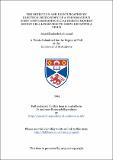Files in this item
The detection and identification by electron microscopy of a polyomavirus (FRKV) contaminating fetal rhesus monkey kidney cell lines used to grow hepatitis A virus
Item metadata
| dc.contributor.advisor | Burdon, M. G. | |
| dc.contributor.author | Richmond, Joan Elizabeth | |
| dc.coverage.spatial | 2 v (230 p., 36 p. of plates). | en_US |
| dc.date.accessioned | 2018-06-15T08:46:04Z | |
| dc.date.available | 2018-06-15T08:46:04Z | |
| dc.date.issued | 1994 | |
| dc.identifier.uri | https://hdl.handle.net/10023/14098 | |
| dc.description.abstract | A continuous line of fetal rhesus monkey kidney cells, FRhK-4, has been used for the propagation of hepatitis A virus (HAV) to prepare diagnostic antigen. While studying the fine structure of HAV grown in these cells, I discovered an unsuspected polyomavirus in both HAV-inoculated and control, uninoculated cultures. The virus, designated FRKV, was also detected in low pass FRhK-4 cultures and in FRhK-6, a cell line used in the development of a live, attenuated hepatitis A vaccine. The presence of an adventitious polyomavirus in FRhK-6 cultures poses questions about the suitability of these cells for vaccine preparation. I have used immunoelectron microscopy (IEM) to identify FRKV, which is not antigenically related to the primate polyomaviruses SV40, SA12, BKV or JCV, but reacts with antibodies that are present in fetal, newborn and adult bovine sera. By IEM the virus is indistinguishable from WRSV, a polyomavirus isolated from calf kidney. FRKV is antigenically similar to recently isolated calf kidney polyomaviruses. I have demonstrated that a commercial pool of fetal bovine serum contains infectious virus and its antibody. FRKV is therefore almost certainly a bovine polyomavirus. IEM has also shown that FRKV is indistinguishable from STMV and CMKV, the polyomaviruses isolated from cultures of stump-tailed and cynomolgus macaque kidney, and is antigenically similar to a polyomavirus from another monkey kidney cell line, LLC-MK2. By implication FRKV is similar to HD, the STMV-like polyomavirus from Vero cells. It thus appears that various monkey kidney cultures from several laboratories have been contaminated with a bovine polyomavirus. It follows that highly sensitive techniques are required for screening bovine sera used in culture media, especially those used in vaccine production. I have explored the use of antibody-coated grids to increase the sensitivity of EM but conclude that the greater sensitivity of DNA amplification techniques might be more appropriate for this purpose. | en_US |
| dc.language.iso | en | en_US |
| dc.publisher | University of St Andrews | |
| dc.subject.lcc | QR416.P7R5 | |
| dc.subject.lcsh | California group viruses | en |
| dc.title | The detection and identification by electron microscopy of a polyomavirus (FRKV) contaminating fetal rhesus monkey kidney cell lines used to grow hepatitis A virus | en_US |
| dc.type | Thesis | en_US |
| dc.type.qualificationlevel | Doctoral | en_US |
| dc.type.qualificationname | PhD Doctor of Philosophy | en_US |
| dc.publisher.institution | The University of St Andrews | en_US |
This item appears in the following Collection(s)
Items in the St Andrews Research Repository are protected by copyright, with all rights reserved, unless otherwise indicated.

